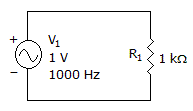Alternating Current vs Direct Current problems
- 1. A sine wave has:
Options- A. four quadrants
- B. two alternations
- C. one period
- D. all of the above Discuss
Correct Answer: all of the above
- 2. What is the waveform period difference between the 60 Hz electricity used in this country and the 50 Hz used in Europe?
Options- A. 3 ms
- B. 16 ms
- C. 4 ms
- D. 20 ms Discuss
Correct Answer: 3 ms
- 3. The current is flowing in what direction?

Options- A. clockwise
- B. counterclockwise
- C. in both directions at the same time
- D. 50% of the time clockwise and 50% of the time counterclockwise Discuss
Correct Answer: 50% of the time clockwise and 50% of the time counterclockwise
- 4. What are the two main applications for ac?
Options- A. direct, pulsating
- B. electric, magnetic
- C. power, information
- D. static, dynamic Discuss
Correct Answer: power, information
- 5. The phase difference between sine waves of different frequencies is:
Options- A. equal to their frequency differences
- B. the difference in their fixed time displacement
- C. the same throughout time
- D. constantly changing Discuss
Correct Answer: the difference in their fixed time displacement
- 6. Test equipment selection enables the technician to both generate signals and:
Options- A. change circuit conditions
- B. inject signals
- C. sense circuit conditions
- D. change signal frequencies Discuss
Correct Answer: sense circuit conditions
- 7. What is the rms voltage value of an ac signal whose peak oscilloscope display uses 3 major divisions above the zero setting? (V/cm = 5)
Options- A. 5.3 V
- B. 10.6 V
- C. 15.0 V
- D. 21.2 V Discuss
Correct Answer: 10.6 V
- 8. Signal comparisons may be most easily seen when using which item of test equipment?
Options- A. spectrum analyzer
- B. multimeter
- C. function generator
- D. dual trace oscilloscope Discuss
Correct Answer: dual trace oscilloscope
- 9. If current varies periodically from zero to a maximum, back to zero, and then repeats, the signal is:
Options- A. direct
- B. alternating
- C. pulsating
- D. repetitive Discuss
Correct Answer: pulsating
- 10. Power companies supply ac, not dc, because:
Options- A. it is easier to transmit ac
- B. there is no longer a need for dc
- C. dc is more dangerous
- D. there are not enough batteries Discuss
Correct Answer: it is easier to transmit ac
More in Electronics:
Programming
Copyright ©CuriousTab. All rights reserved.
